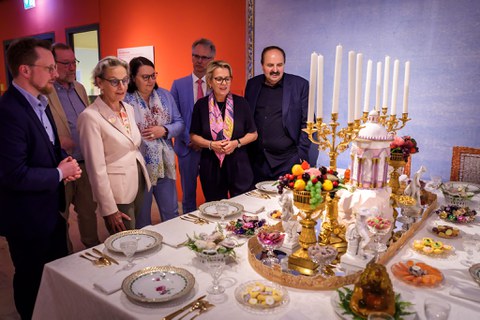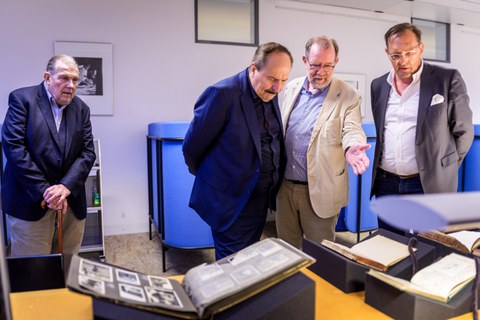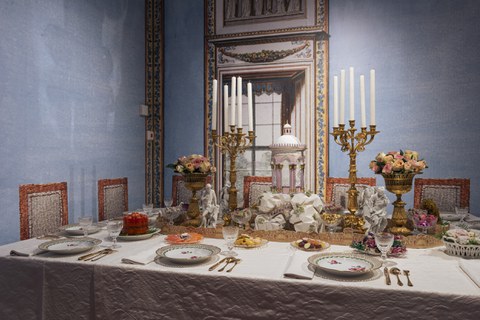Jun 13, 2025
The first exhibition of the German Archive of Culinary Arts opens its doors in Dresden with a keynote speech by Johann Lafer: "The Sweet Art - A Cultural History of Confectionery and Desserts"

From left to right: Dr. Janosch Förster (German Archive of Culinary Studies, SLUB Dresden, curator), Prof. Josef Matzerath (German Archive of Culinary Studies, TUD, curator), Prof. Ursula Staudinger (Rector TUD), Katrin Stump (General Director of SLUB Dresden), Prof. Andreas Rutz (Chair of History of Saxony at the TUD and designated spokesperson for the Culinary Research Group at the TUD), Barbara Klepsch (Saxon State Minister for Culture and Tourism), and Johann Lafer.
On June 12, 2025, the Saxon State and University Library (SLUB) and TUD Dresden University of Technology inaugurated the first exhibition of the German Archive of Culinary Arts with a keynote speech by the professional chef and pastry veteran Johann Lafer: The Sweet Art - A Cultural History of Confectionery and Desserts. The exhibition is free and will run from June 13, 2025 to January 17, 2026 in the Book Museum of the SLUB Dresden (Zellescher Weg 18, 01069 Dresden, 2nd floor). The Book Museum is open from Monday to Friday, from 10:00 am to 6:00 pm, and on Saturday, from 2:00 pm to 6:00 pm.

Johann Lafer (2nd from left) at the exhibition opening.
Johann Lafer, a renowned dessert expert, said a few words to mark the opening of the event: He first created "à la minute" desserts around 1980 - in other words, desserts that are served immediately after preparation. This innovation still shapes the way that desserts are served in German gourmet restaurants today. Turning his attention to the archive, Johann Lafer says: "This exhibition precisely reflects the constant change that also characterizes my philosophy of good taste. The focus is not on short-lived trends, but on the thoughtful, heart-felt development of an art that has given people pleasure for centuries."
Barbara Klepsch, Saxon Minister of State for Culture and Tourism, emphasizes: "Cooking is a living culture, with desserts and confectionery constituting its sweetest form of expression. Cuisine is a central component of cultural identity. Desserts in particular - from Black Forest gateau to Saxon pancakes - tell this story of rich family traditions and craftsmanship. It is therefore important to preserve, research and communicate dessert culture as a form of culinary heritage. Cuisine now also plays a big role in tourism. Travelers are seeking out authentic regional specialties, which means that culinary tourism is starting to boom. The new exhibition pays tribute to confectionery and desserts as cultural heritage across generations and makes it clear how deeply they are connected to our society."
"With this exciting exhibition, the SLUB Dresden and TUD are giving the general public a comprehensive insight into the research and collections of the German Archive of Culinary Arts for the very first time, which currently comprises more than 50,000 cookbooks, magazines, historical menus, audio-visual materials and other fascinating objects," says Katrin Stump, Director General of the SLUB Dresden. "On display are incunabula from when printing was first invented, as well as historical manuscripts and video recordings from the program to safeguard the audio-visual heritage in Saxony," continues Stump.
Using historical sketches, books and exhibits, such as a flip-flop on which desserts were served in the former two-star restaurant FALCO in Leipzig, the cultural history of confectionery and desserts from the Middle Ages to the present day is recounted. The research tell us: Sweet dishes are more than just a tasty treat. Tarts, ice creams and chocolates are an expression of aesthetic developments. Confections and pâtisseries tell stories of culture, craftsmanship and social change. At the same time, desserts, cakes, ice creams and chocolates offer illustrative approaches to current findings in food studies: How has the design of sweet dishes changed over the centuries? Which flavors from other continents were used in European kitchens? How did industrialization and consumerism shape the confectionery industry?
"The Sweet Art exhibition reveals fascinating insights into the cultural history of desserts in collaboration with the SLUB. At TU Dresden, we are focusing on the culinary-aesthetic design in confectionery, its historical development in Europe and the manifold references to social changes. We combine historical approaches to nutrition with scientific findings from food chemistry, while at the same time delving into soft matter food physics and medical matters. This exhibition is an excellent example of a living partnership between TUD and the SLUB Dresden. Owing to its interdisciplinary nature, it permits access to a previously almost untapped area of research in a vivid and incredibly comprehensibly way," explains Prof. Ursula Staudinger, Rector of TUD.
Background information on the exhibition
A delicately melting praline, the scent of caramel, an artfully decorated cake - the world of sweet temptations is a wonder that appeals to all the senses. But desserts and the art of confectionery are much more than just pure indulgence: They reflect social developments, artistic trends and scientific findings. The exhibition takes visitors on a journey through the centuries. The cultural history of key ingredients such as sugar and cocoa is highlighted, as is the culinary and aesthetic development of many sweet creations. Scientific findings provide important insights into the world of aromas.
The cultural history of confectionery and desserts is told in four distinct chapters:
- The origin of confectionery (ingredients, dishes and their historical roots from the Renaissance to 1800)
- The aesthetic development of artisan confectionery from 1800 to the present day
- Sweet indulgence - explained scientifically
- Industrial manufacturing and domestic production
At the same time, visitors are invited to engage their senses at a smell station, for example, or to share their personal favorite dessert on an interactive wall. The accompanying program includes curator tours, scientific lectures, a poetry slam and practical dessert workshops in cooperation with the Volkshochschule Dresden. Would you like to know more about the exhibition its accompanying program? www.slubdd.de/suessekunst
German Archive of Culinary Arts
The German Archive of Culinary Arts in Dresden is the largest publicly accessible collection of cookbooks and menus in the German-speaking world. The Saxon State and University Library (SLUB) and TUD Dresden University of Technology founded the German Archive of Culinary Arts on October 10, 2022. The extensive collection of culinary publications, including manuscripts, books, journals, menus, advertisements, photographs and audio-visual material, is one of the most significant of its kind in Germany. Its highlights include collections of Ernst Birsner, Walter Putz, Wolfram Siebeck and Eckart Witzigmann. It forms the basis for interdisciplinary and transdisciplinary research in the humanities, cultural studies and natural sciences regarding culinary art, dining culture and nutritional science as well as their impact on culture and society over the ages, as already successfully established at TUD. In future, the extensive holdings of the German Archive of Culinary Arts will be digitally indexed in a project funded by the German Research Foundation and made available in an online portal. This means that they will be available free of charge to both the scientific community and the general public.
The SLUB and TUD invigorate the scientific and societal discourse related to nutrition and culinary arts by organizing events, exhibitions, participatory formats, and publications, thus establishing the German Archive of Culinary Arts as a pivotal player in research, teaching, and the transfer of knowledge to society.
For more information on the German Archive of Culinary Arts, please visit www.archivderkulinarik.de.
Contact
Annemarie Grohmann, M.A.
SLUB Dresden Press Officer
Tel: +49 351 4677-342
Email:
Matthias Fejes
TUD Press Officer
Tel.: +49 351 463-329882
E-Mail:

